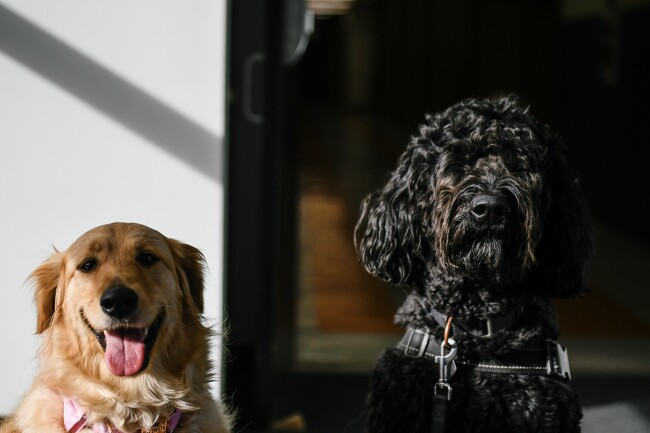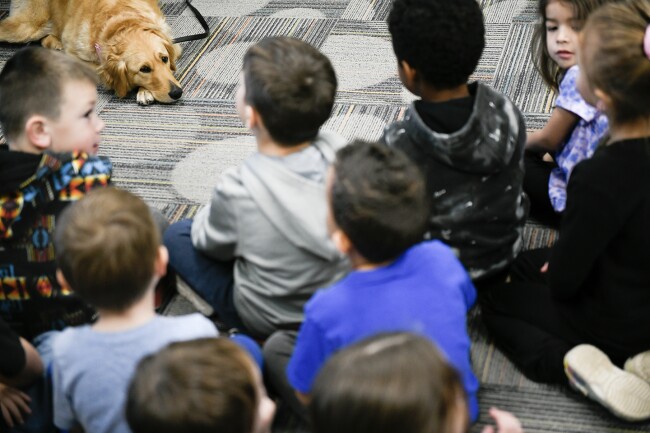Sometimes students say few words to school counselor Kelli Baker as they walk into her office, making a beeline for Kalani, a golden retriever/poodle mix that has been trained to work as a school therapy dog.
Morris, Okla., elementary school students who are stressed, struggling to manage big emotions, or dealing with crises at home bury their faces in Kalani’s golden fur and slow their breathing to match her relaxed presence.
It’s not uncommon for schools to teach children breathing exercises and calm-down techniques. In Morris, having two therapy dogs causes some students to do those things intuitively, said Baker.
“They work through those emotions and say, ‘Hey, Ms. Baker, I’m ready to go back to class,’” she said.
For others, the dogs provide a sense of safety that helps them gather the courage to ask adults for help.
“Kids will come in closed-off and reserved,” Baker said. “I don’t ask anything. They are just on the floor playing with the dog and they start sharing with me.”
Facing a worsening youth mental heath crisis, more schools have brought therapy dogs on board to help students cope. Some integrate the animals into academic work, using them in interventions for students with disabilities or as part of classroom engagement strategies.
“Particularly if a student loves animals, we see some wonderful growth,” said Jennifer VonLintel, a school counselor at B.F. Kitchen Elementary School in Loveland, Colo.
It’s clear that the pandemic has contributed to a growing interest in bringing therapy dogs into schools. Districts in states including , , , and have even used portions of the $123 billion in K-12 relief funding provided through the American Rescue Plan to pay for specialized therapy dog training, which can cost thousands of dollars.
More than just classroom pets
Formal therapy dog work dates back to use in hospitals in the 1970s, but it has become more prevalent in recent decades, especially in educational settings. And as more academic research emerges on the benefits of the human-animal bond, schools are working with canine companions in more sophisticated ways.
School therapy dogs are not just classroom pets, said VonLintel. Rather, school social workers, counselors, physical therapists, behavior interventionists, and special education teachers integrate them into specific tasks with students, she said.
For example, students with developmental disabilities may learn improved communication skills by directing the animals to sit or stay. Some children practice behavioral management by studying the signs that a dog is feeling relaxed—like ears that hang loosely rather than laying flatly against the head.

“When people approach me and say that they want to bring a dog to school, my first question is, ‘What is your goal?’” said VonLintel, who has worked with researchers to publish papers on .
Therapy dogs are trained to provide support in a community environment. They differ from service dogs, which are trained to assist individuals with specific tasks related to physical disabilities.
When VonLintel and a golden retriever named Copper started her school’s therapy dog program 14 years ago, she couldn’t find specific training locally, so she worked with a Colorado trainer to adapt service dog training to fit the needs of a school environment.
The program grew from there. This year, six teams of volunteer handlers will bring dogs ranging from a chihuahua to a Bernese mountain dog into the Loveland district’s schools.
In addition to monitoring the dogs’ interactions with students, the handlers have learned a bit about academic skills, like reading, so they can ask follow-up questions to guide students’ comprehension as their dogs sit with small groups during read-aloud sessions.
“I’ll say, ‘I don’t think Toby understood what was going on on those last two pages,’” VonLintel said, referring to her current therapy dog, a small brown cavalier King Charles spaniel mix. “‘Can you tell him what was happening in the story?’”
Sit, stay, and study
A private Facebook page VonLintel started to share her experiences in founding the therapy dog program now has 9,000 members who trade tips on training, school board policies, insurance, and how to incorporate animals into therapy and instruction.
Interest in the Loveland district’s use of therapy dogs has grown to the point that it now offers an on-site, evening training program, where interested staff members can bring their own dogs to learn in a school environment.
The dogs practice everything from basic commands to remaining calm and quiet in the unpredictable situation of a classroom lockdown drill. They must pass an evaluation before they can work in a school, and they must be regularly reevaluated to continue that work in future years.
Training is also key for handlers, who must learn to recognize when a dog is tired or stressed and monitor its interactions with students, said Helen Holmquist-Johnson, director of Human-Animal Bond in Colorado, a research center at Colorado State University that helps train and screen volunteer handlers to work in 30 schools in the region. Researchers there also study the effects of animal-assisted interventions, and develop approaches for students with specific conditions like autism.
Holmquist-Johnson recommends vetted, well-developed training programs like those offered by Pet Partners, a nonprofit organization for volunteer handlers.
Launching a school therapy dog program with community support
Access to training was a big concern for Baker, the counselor in the Morris, Okla., district, where the therapy dog program is still in its infancy.
The rural school system had not had an elementary school counselor in over 20 years when Baker started there in 2021, her position funded by a state grant.
In her first few weeks on the job, she noticed that students were struggling with behavior and emotions after months of COVID disruptions—part of a national trend. The American Academy of Pediatrics and the U.S. Surgeon General have sounded the alarm about a youth mental health crisis worsened by the pandemic.
In Morris, some children had lost family members—and some were just uncomfortable in the school environment. Those students seemed to be “frozen in time,” still in the place they were developmentally at the beginning of the pandemic, she said.

Baker had experience working with therapy dogs in her previous role in the juvenile justice system and thought they might be a good fit for Morris.
She was early in her research when she got a call from a breeder about the dog she later named Kalani. She was the one puppy left in a litter of what are commonly known as goldendoodles—a mix of of golden retriever and a poodle bred with the intention of creating a lower-shedding coat. Unlike the other puppies, Kalani wasn’t born with a curly coat, and people were less interested in buying her.
The breeder offered to donate Kalani to the district for use as a therapy dog. Later, another breeder donated Shadow, a black goldendoodle who is handled by the elementary school’s librarian and occasionally works in the district’s high school.
Morris schools designated the dogs as property of the district, and not the employees who handle them at school and care for them at home. That allowed Baker, librarian Lisa Merrill, and Principal Becky Alexander to add the animals to the district’s insurance plan and to raise money that helped pay for training.
The $10,000 in private donations covered an intensive boarding program that allowed the dogs to learn on-site at a training facility for several two-week sessions, and additional handler training for Baker and Merrill that worked with their schedules.
That training prepared the dogs to remain calm and disciplined in unfamiliar environments. They went to Wal-Mart and Sams Club to get exposed to crowds and noises, like shopping carts and fork lifts, so that they’d be comfortable around mobility aids like wheelchairs and students with various visible disabilities.
The community quickly recognized the benefits of the dogs, whose harnesses bear the logos of some businesses that helped covered training costs, Alexander said.
“So many schools are in the same boat as us,” she said. “They say, ‘I want to do it. We’ve got our team, but we don’t know the steps to do it,’” she said.
Answering logistical questions about school therapy dogs
VonLintel, the Loveland counselor, recommends coordinating with trained volunteer handlers who bring in their own dogs and manage things like training, certification, and insurance. Such a model is less expensive and challenging than building a program from scratch.
69��ý can contact local volunteer handler groups or consult organizations like or the American Kennel Club to locate teams, she said.
Whatever model a school uses, dogs should be given plenty of days off and time to rest on-site so they don’t burn out in a high sensory environment, VonLintel said.
Toby, who was rescued as part of an animal welfare investigation, comes to school one day a week. He spins in excited circles when he sees VonLintel pick up the backpack that contains the gear he needs to go to work. If he ever looked tired or hesitant, she would leave him at home.
Among other common logistical questions:
- Insurance for on-site dogs—which covers the cost of liability in the event the animals injure a person—may come through a professional organization, like a school social workers organization, through the school’s existing insurance plan, through a handler’s homeowner’s insurance, or through a supplemental plan, depending on various state and local laws.
- 69��ý with therapy dogs must send forms home to parents to identify students with allergies or aversions to dogs. They should do the same for staff, and handlers work to avoid classrooms or spaces where people may be uncomfortable.
As would-be handlers select dogs to train for therapy work, Holmquist-Johnson, of Colorado State University, said the individual animal’s personality matters far more than the breed. School handlers should look for an animal—whether a purebred puppy or a mixed-breed shelter dog—that is friendly and eager to engage, she said.
“Our number-one qualifier is that they have to love people,” she said.
Building on that foundation, well-trained dogs can serve a variety of purposes in schools, handlers said. Some may greet kindergartners anxious about leaving their parents on the first day of school. Some may play fetch with a student as a reward for improved behavior in the classroom. Some may sit and listen as two students talk through a conflict with their school counselor, serving as both a living mascot and a comforting bit of familiarity.
Sometimes, teachers even stop to center themselves with Shadow after a stressful day, Merrill said.
“Everybody is carrying a lot of extra weight these days,” she said. “Having them provides an outlet for everyone.”











